Challenger 3 tank: briefly about the British transition to a smoothbore gun
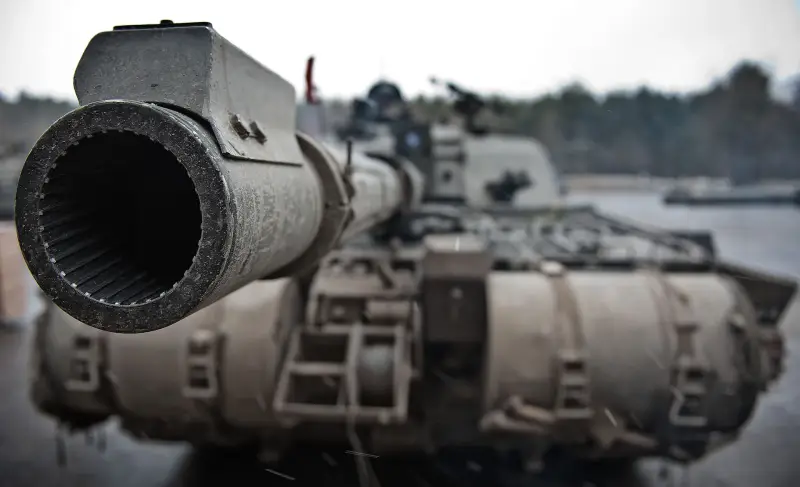
It is no longer a secret that the British army finally decided to modernize its aging tanks Challenger 2, with the goal of extending their service life until at least the 2040s. The budget for this project is approximately a billion dollars, and the scale of improvements even became the reason for giving the post-operation machines a new name, “Challenger 3.”
According to plans, the tanks will receive a completely new turret and electronics, modular armor and active protection, as well as major changes to the suspension and power plant. But perhaps one of the most significant innovations is the replacement of the rifled gun with the smoothbore L55A1 from Leopard 2.
Let's say a word about the rifled gun
Generally speaking, the weapons of Challenger 2 seem very exotic in modern times and, to some extent, even smack of archaic. After all, a third-generation tank with a rifled gun is a rare combination against the backdrop of the total dominance of smooth-bore artillery in world tank building.
It’s hard to disagree here: “rifling” completely went out of fashion many years ago. However, it cannot be said that the gun of a British tank is completely incapable of anything. According to its characteristics, it suited the military quite well, and even now it has not completely lost its relevance.
Let us remember that we are talking about a 120-mm L30A1 gun with a barrel length of 55 calibers, developed in the 80s of the last century. In fact, this is the eighth and most radical modification of the L11 artillery system, which was installed on the Chieftains and then on the Challengers 1.
The product, of course, is specific, which is noticeable in the separate-cap loading scheme with a three-component shot, consisting of a separate projectile, propellant charge and ignition tube. And its ammunition is traditionally English, consisting of sub-caliber, armor-piercing high-explosive and smoke shells.
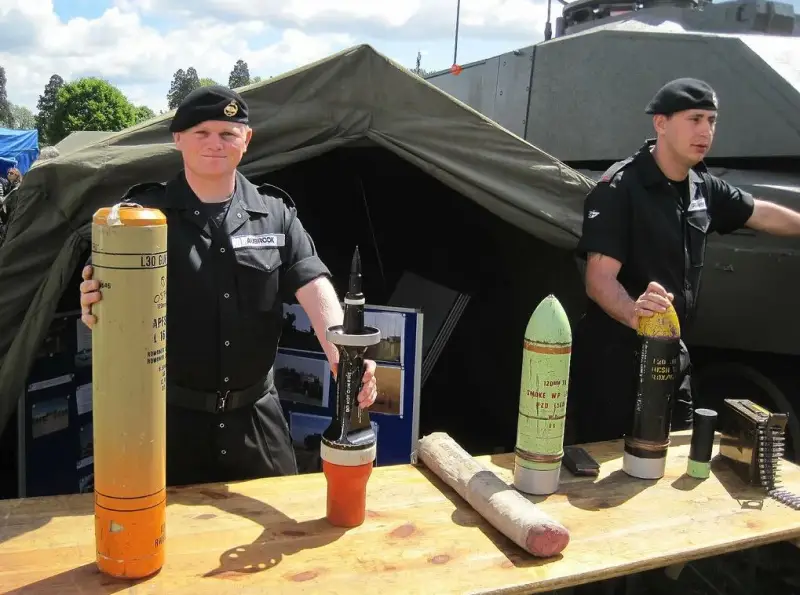
Challenger 2 ammunition from left to right: L27A1 sub-caliber projectile, Smoke WP smoke projectile, HESH armor-piercing high-explosive projectile
Otherwise, despite its features, the gun is extremely accurate when firing at long distances, which is inherent in all rifled guns. With a lifespan of 400 rounds on a full charge, which is large for this cohort, the old L11, for example, could boast only 120 rounds before significant barrel wear began. But that's not the main point.
The main advantage of the L30A1 is its anti-tank capabilities, which were not much different from those of smooth-bore guns in the 90s and 2000s. In this case, engineers from Foggy Albion did their best, squeezing the maximum out of the gun due to the new technology of its manufacture, which included chrome plating of the inner surface of the chamber and barrel in combination with its autofrettage (creation of residual stresses).
As a result, it was possible to achieve both the aforementioned long service life of the gun and to increase the maximum pressure in the barrel bore to 600 MPa or more using high-energy propellant charges.
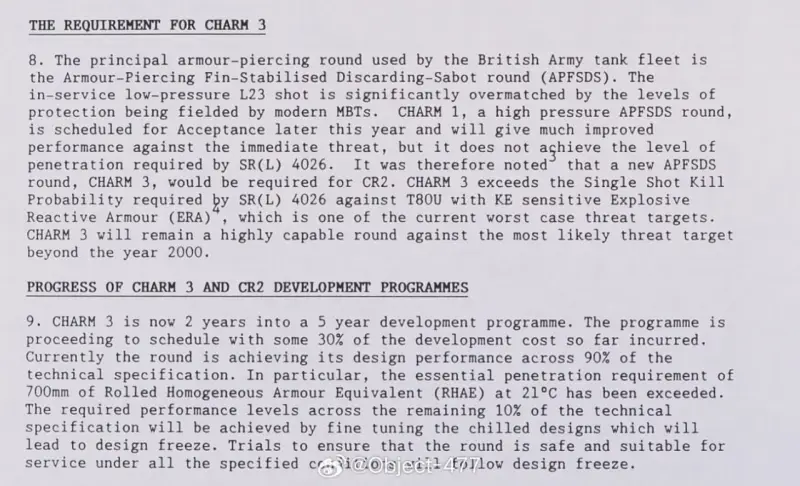
Fragment of a report on the development status of the L27A1 projectile (CHARM 3). Indicates that the requirements for armor penetration of 700 mm of steel armor are exceeded
All this made it possible to create powerful uranium finned L27A1 sub-caliber projectiles with armor penetration of about 700 millimeters of medium-hard steel armor. This was more than enough to destroy any Soviet-type tanks, including the most armored T-72B and T-80U with Kontakt-5 dynamic protection.
In principle, even today the gun can hardly be called completely outdated. She can still show her strengths on the battlefield. Although it could have shown more if it had high-explosive fragmentation or specialized anti-personnel shells in its ammunition. But these are problems for the military and manufacturers - the rifling and design do not interfere with this.
Reasons for replacing with a smoothbore
Indeed, the L30A1 is not yet a completely decrepit old lady, but what are the reasons for replacing it with a smoothbore gun? Often, as an answer to this question, a very widespread opinion is given that the British are very concerned about the lack of shell unification of their tank with its NATO “brothers” in terms of difficulties in supplying ammunition.
It is pointless to deny this fact, since Challenger 2 with its cannon looks like a black sheep compared to the vast majority of combat vehicles of a similar class, armed with smooth-bore guns. This circumstance negatively affects the interoperability of NATO troops and, in theory, could affect the combat effectiveness of the British army in large-scale and local military operations.
However, if the problems of the L30A1 concerned only this aspect, then the highest military officials in Great Britain would hardly have decided to seriously modernize their tanks. There are actually two more reasons besides this one.
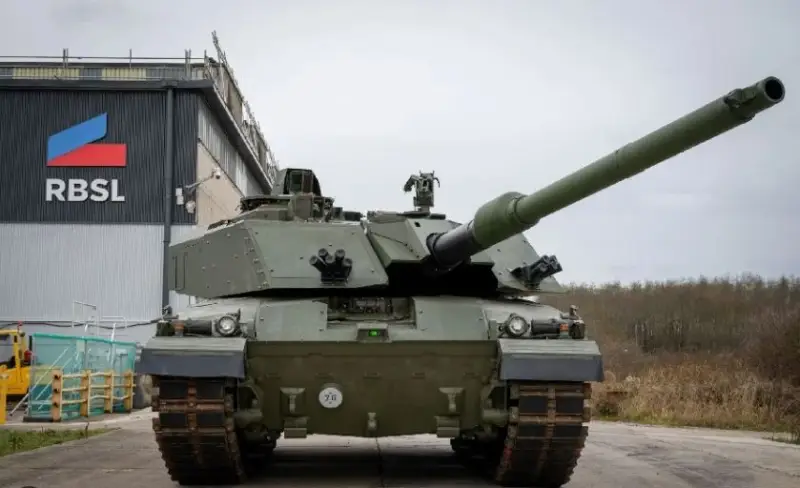
Challenger 3 prototype with new turret and German L55A1 smoothbore gun
The first is the production of standard ammunition. The British practically lost it due to the lack of appropriate military orders, the systematic reduction in funding for the military industry and the process of its privatization.
For example, the last batch of L27A1 sub-calibers was produced in 2001, and as of 2006, their production lines were completely closed. Also, the production of the English calling card - armor-piercing high-explosive shells - has long ceased to exist in the country. They are now made in small batches by a Belgian company far outside the UK.
In other words, the British actually live mostly on stocks. You can’t fight much with them, as they say. And in peacetime, ammunition tends to go to waste due to the expiration date. However, the restoration of their production, and even more so the development of new ones, is fraught with extremely high costs, which, in principle, cannot be significantly reduced due to mass production.
This requires a large and constant demand for products. But it is not and will not be, since the only consumers of specific shells for the 120-mm rifled gun are the UK tank fleet, limited to a couple of hundred Challenger 2s, as well as Oman, which has only 38 tanks of this type.
In the current situation, equipping the Challenger 2 with a smoothbore 120-mm cannon is the only way through which the UK can gain access to cheap and advanced shells by purchasing them from Germany or the USA.
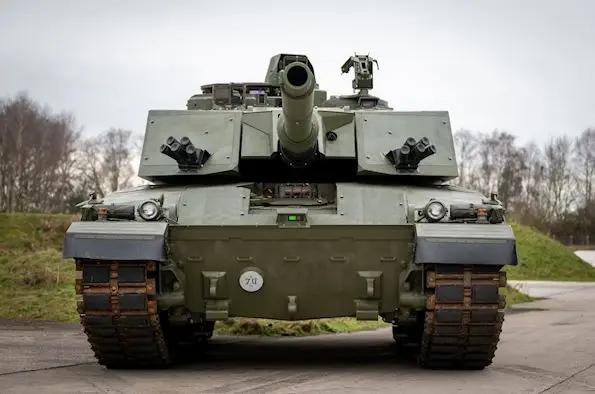
The second and most important reason for switching to a new gun is related to increasing the firepower of the tank due to the possibility of using the most modern sub-caliber shells.
Of course, L27A1 is still relevant today - and will be relevant in the near future. But in the future, the old Challenger 2 cannon will no longer be able to cover all the needs in the fight against armor, even if the British decide to produce ammunition.
This is due to the fact that in a rifled barrel it is physically impossible to provide the same high maximum pressure when firing as in a smooth one. The L30A1’s is significantly lower than that of the old German 120-mm L44 cannon and its counterpart on the Abrams tank, with values exceeding 700 MPa.
Based on this, a significant increase in the initial velocities of projectiles or their maintenance with increasing length and mass of the core is greatly limited. Moreover, the rifling also means a larger friction area and a heavier driving device for guiding the projectile in the barrel and sealing off the powder gases.
So it is impossible to create a projectile that would be similar in penetration to modern American and German models. But after installation, the guns can be bought either from the same Germans or from the Americans.
In addition, a smoothbore gun will lead to an expansion of the tank's anti-personnel functionality, which, as we noted earlier, was severely limited. And this, it must be said, is a weighty argument, since the Challenger 2’s only high-explosive armor-piercing projectile containing explosives is not suitable for these purposes.
Its effectiveness against buildings and fortifications seriously lags behind new Western developments, and against openly located manpower it is completely comparable to 85-mm high-explosive fragmentation grenades. Based on this, equipping the vehicle with cumulative fragmentation and multi-purpose programmable projectiles of the DM11 type will multiply its combat capabilities.
In general, the choice of new ammunition for the updated Challenger is large and depends only on the compliance of the manufacturing country. But, according to some sources, the British are seriously looking at the most promising types of projectiles, including the latest overseas uranium “crowbars” M829A4.
Conclusions
Indeed, the prospects that a smooth-bore gun paints are very tempting, and the British simply have no other choice in preserving the combat effectiveness of Challenger 2. Therefore, adding it to the list of mandatory tank upgrades as part of modernization looks like a completely justified decision.
Of course, a lot of money will be spent on this from the planned budget, since due to the installation of the gun it was necessary to install a completely new turret, since in the old one it is simply impossible to organize a place for storing 120-mm unitary rounds. But the benefits of the events are obvious.
It should be taken into account that the new weapons will also be supplemented by a modern fire control system, including third-generation thermal imagers, an automatic target tracking system, the integration of a “digital battle space” and other innovations that significantly increase the tank’s capabilities on the battlefield. In short, the Challenger will be fully packed.
Information